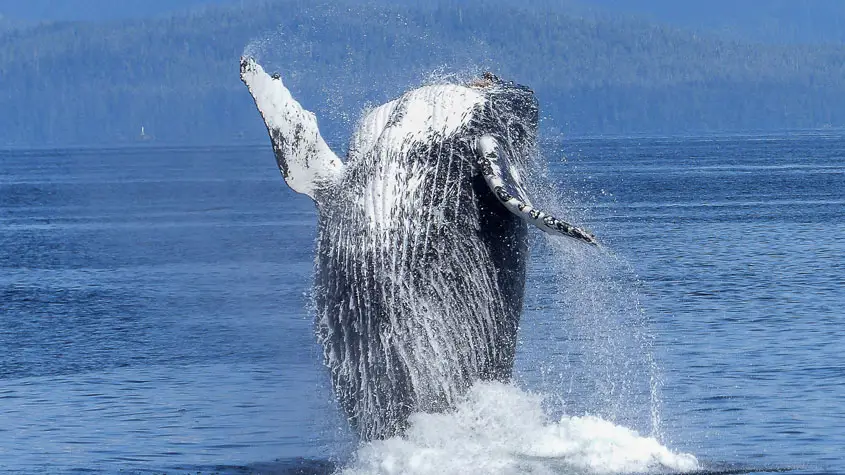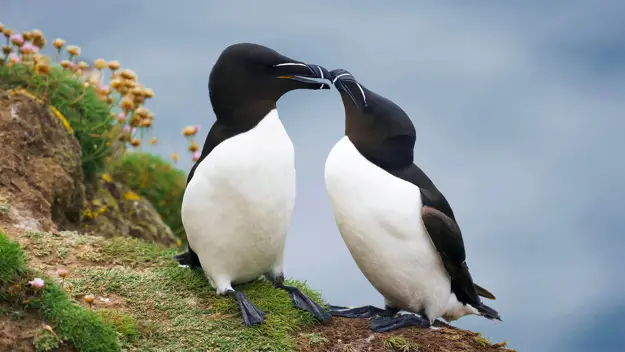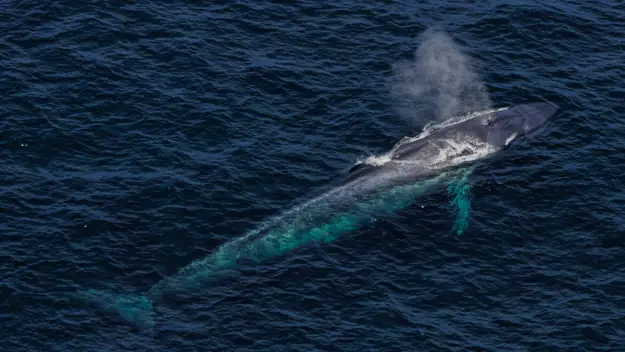Thirteen whale species to discover
Thirteen different whale species coexist in the waters of the St. Lawrence River. According to scientific classification, different types of whales and dolphins are all grouped in the cetacean category. The word cetacean comes from a Greek term, meaning sea monster. It's no wonder how this nickname came to be when the majority of humpback whales have a length longer than a school bus!
Whales are divided into two main groups: toothed whales and baleen whales. Belugas, blue whales, minke whales, fin whales, humpback whales, harbour porpoises, right whales, killer whales, sperm whales, narwhals, white-nosed dolphins, white-sided dolphins, northern bottlenose whales are amongst the species you can come across during your excursion on the St. Lawrence.
AML Cruises offers a multitude of cruises and excursions on the St. Lawrence River and the Saguenay Fjord with departures from different ports in the province. You will navigate towards one of the best locations in the world to admire marine mammals from up close. To ensure that you experience is a unique encounter, the company has implemented the whale warranty. According to the warranty, if the captain deems that no whale was observed during your cruise, you will get a ticket for another whale watching cruise or a guided day cruise in Montreal or Quebec City.
Discover the species living in the St. Lawrence River.
The beluga
Around 900 beluga whales can be found around the world. This marine mammal, sometimes called sea canary, extends its territory from the estuary to the gulf, though the Saguenay Fjord, usually found in strong current waters. It’s the only year-round resident of the St. Lawrence. The beluga feeds on ground fish, eels and invertebrates using its teeth to chew on its prey that it swallows without chewing. Between whistles, clicks, squeaks and grunts, its vocal range is diverse. Mating takes place between April and June and gestation lasts 14 months while breast-feeding lasts between 6 to 24 months. Iconic for their dazzling whiteness, beluga whales don’t have this appearance throughout their lives. Babies are gray but female belugas will turn white at about 7 years old and males at 9 years old.
The fin whale
This cetacean is found in the gulf from May to the end of November. Around 380 whales have been registered in the river, excluding the estuary. Fin whales are faithful to their feeding spot. This whale species is a gulp feeder which means it engulfs a large quantity of water and small prey at a time and then rejects water while swallowing the food. It belongs to the family of baleen whales. Its diet consists of planktonic crustaceans and small fish. The sounds of fin whales are in the low frequency range of less than 120Hz. Breeding occurs between December and January, gestation lasts 11 to 12 months and breastfeeding lasts 6 to 7 months. While its back is dark gray, its belly is pale. It measures between 20 and 25 meters and its lower jaw is white.
The minke whale
Like the fin whale, the minke whale is found in the coastal areas, from March to December when it comes to feed. Around 1,000 individuals have been registered in the region, excluding the estuary. It is clever when it comes to capturing its prety. The smallest minke whales will spend half their time hunting during summer. It is also a gulp-feeder who feeds on krill and small fish, mostly herring and capelin. It also produces low-frequency sounds. As for reproduction, mating takes place between January and May, gestation lasts about 10 months and breastfeeding lasts 4 to 5 months. The minke whale has a dark grey back and a white belly. It boasts a broad white band that crosses each pectoral fin. Very similar to the fin whale, it is distinguished by its length as it measures 8 meters compared to the usual 20 metres of its peers.
The humpback whale or rorqual whale
Each spring, more than 7,500 humpback whales travel 5,500 kilometres to reach the North Atlantic Ocean and the St. Lawrence River. Since the late 1990s, these whales can be found more and more in the St. Lawrence and gulf regions. The humpback whale hunts planktonic crustaceans and small fish, either alone or in groups. To attract females and prove their dominance, males emit long, melodious and complex chants during breeding season. Gestation lasts from 11 to 12 months and breastfeeding lasts from 5 to 10 months. Their back is dark gray and their belly is white. They can be distinguished by their long pectoral fins that measure up to 4 meters and with their tail, unique to each whale. You can admire it as it dives deep in the cold waters of the St. Lawrence. A great picture to capture and cherish!
The harbour porpoise
Of all the species present in the St. Lawrence, harbour porpoises have the shortest life span, yet their population is estimated at about 20,000. They are mostly seen in bays, estuaries, fjords, and ports. This whale species feeds in the water column, mostly from pollock, capelin, mackerel and on the bottom, mostly squid and crustaceans. Harbour porpoises emit repeated clicks but also low frequency sounds that are used to communicate as well as to locate their position since these ultrasounds echo against the object before returning it, which allows them to estimate the distance with the object. Mating takes place between July and August and gestation lasts about 10 months. They have a robust body with a dark back and lighter belly. They are close to a human in size.
The blue whale
The blue whale, known as Earth's largest mammal, usually frequents deep and cold waters. It resides in the gulf and estuary during summer, mostly seen in August and September. Like all other whales, it is part of the family of baleen whales and feeds on krill, up to 4 tons per day, which corresponds to the weight of two cars! Mating occurs in late fall or winter. Rare and fragile, the blue whale remains one of the most beautiful mammals to observe. Measuring between 24 and 31 meters, it can be recognized by its bluish gray tail and of course its size!
The right whale
Hardly visible on the surface, the right whale frequents coastal and shallow waters of the St. Lawrence. Right whales swim with their mouths wide open and filter the water as they move, capturing tiny crustaceans called copepods, also making them gulp feeders. Mating takes place in winter, between November and February. Their back and belly are black, sometimes dotted with white spots. They also have whitish calluses on their entire head.
The northern bottlenose whale
Champion for its diving skills, both in time and depth, the bottlenose whale has a varied diet ranging from squid, herring and shrimp to cucumbers and starfish. Birth takes place from April to June. It is 6 to 10 meters in length and can be identified by its prominent beak, similar to a dolphin's.
The sperm whale
As the largest toothed cetacean, the sperm whale is occasionally seen in the gulf and the estuary. It swims mainly in the Northwest Atlantic where its population is estimated at nearly 2,700 individuals. The sperm whale spends the better part of its time searching for food in depths. It favourite meal is squid. Breeding occurs in spring, followed by a long gestation period of 14 to 16 months. Its skin is dark and its squared, prominent head occupies one-third of its body.
The killer whale
With only about twenty sightings since the early 1980s, killer whales are scarce on the gulf and the estuary. Thanks to its high capacity for adaptation, it knows how to take advantage of oceanographic conditions and diversified food resources. Killer whales follow a very varied diet: small fish, squid, turtles, seals, seabirds, rays but also sperm and larger whales. Breeding occurs year-round, peaking in spring and fall. Killer whales are known for their characteristic black and white patterns.
White-sided or white-nosed dolphin
A regular visitor of the gulf from spring to fall, mostly off the Lower North Shore, the white-sided dolphin and the Atlantic white-nosed dolphin also venture into the Gaspé Peninsula and approach the coast during summer and fall. Their population number, in this region, are estimated at 12,000 for the white-sided dolphin and 2,600 for the white-beaked dolphin. Their diet consists of small fish that live in the depths, mostly squid and sometimes small benthic crustaceans. Dolphins usually live in groups of three to fifteen individuals. Breeding occurs from May to September, peaking in June and July.
The narwhal
Belonging to the subspecies of odontocete cetaceans, commonly known as toothed whales, narwhales, like sperm whales and dolphins, are more comfortable in areas covered by dense ice in winter. They get food in deep waters. They are suited to live in cold waters and rarely adventure into warmer regions where they might encounter more predators. Narwhals are sociable animals; they live in groups and communicate with each other by hissing. Since 2016, a young narwhal has indeed been seen wandering the St. Lawrence River as part of a group. Its color changes during its life but the male can be easily distinguished with its twisted horn, sometimes up to 3-meters long.
The St. Lawrence is prized for marine life observation as a lot of whales crowd it which explains why the Saguenay-St. Lawrence Marine Park is the most beautiful whale watching site in the world. If you wish to experience an excursion like none other, come aboard one of AML's boats or Zodiacs for a cherished encounter with these fascinating sea monsters!




